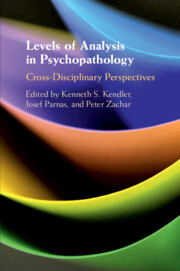Book contents
- Levels of Analysis in Psychopathology
- Advance Praise for Levels of Analysis in Psychopathology
- Levels of Analysis in Psychopathology
- Copyright page
- Contents
- Figures
- Tables
- Contributors
- Preface
- General Introduction
- Part I Neuroscience, Mechanisms, and RDoC
- Part II Phenomenology, Biological Psychology, and the Mind–Body Problem
- Section 4
- Section 5
- Section 6
- Section 7
- 19 Introduction
- 20 Challenges in the Relationships between Psychological and Biological Phenomena in Psychopathology
- 21 Non-reductionism, Eliminativism, and Modularity in RDoC: Thoughts about a Progressive Mechanistic Science
- Part III Taxonomy, Integration, and Multiple Levels of Explanation
- Index
- References
21 - Non-reductionism, Eliminativism, and Modularity in RDoC: Thoughts about a Progressive Mechanistic Science
from Section 7
Published online by Cambridge University Press: 02 April 2020
- Levels of Analysis in Psychopathology
- Advance Praise for Levels of Analysis in Psychopathology
- Levels of Analysis in Psychopathology
- Copyright page
- Contents
- Figures
- Tables
- Contributors
- Preface
- General Introduction
- Part I Neuroscience, Mechanisms, and RDoC
- Part II Phenomenology, Biological Psychology, and the Mind–Body Problem
- Section 4
- Section 5
- Section 6
- Section 7
- 19 Introduction
- 20 Challenges in the Relationships between Psychological and Biological Phenomena in Psychopathology
- 21 Non-reductionism, Eliminativism, and Modularity in RDoC: Thoughts about a Progressive Mechanistic Science
- Part III Taxonomy, Integration, and Multiple Levels of Explanation
- Index
- References
Summary
In a commentary on Miller and Bartholomew, Zachar notes that the Research Domain Criteria initiative (RDoC) has always represented an incursion of cognitive neuroscience and factor analytic dimensional models from psychology into biological psychiatry, and that non-reductionist aspirations have been a part of RDoC from the beginning. Rather than reductionism, a more problematic tenet of the RDoC initiative is a contempt for the categories of the DSM, seen in a tendency to blame the lack of progress on adherence to a categorical model rather than on the intrinsic complexity of psychopathology.One aspect of this complexity is the open nature of psychological concepts.Turning to the “neural circuit” metaphor, Zachar suggests that the notion of a “circuit for” may reflect adopting too modular a theory of mind, which as a framework, may unnecessarily constrain a mechanistic science.
- Type
- Chapter
- Information
- Levels of Analysis in PsychopathologyCross-Disciplinary Perspectives, pp. 267 - 274Publisher: Cambridge University PressPrint publication year: 2020

